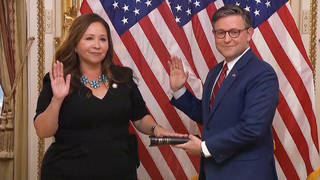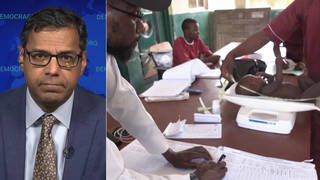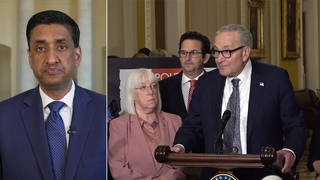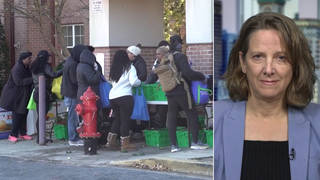
Guests
- Dani Not Help Himtribal member of the Oglala Lakota Tribe. She has worked with the Housing Authority to start an empowerment zone in her reservation, and works at the Red Cloud Indian School. She lives on the Pine Ridge Indian Reservation.
- Linda Brockchair of the mining subcommittee of Kentuckians for the Commonwealth, speaking from Knox County, Kentucky.
- Holly Sklarco-author of a new book, Shifting Fortunes: The Perils of the Growing American Wealth Gap, published by United for a Fair Economy, and author of Chaos or Community?: Seeking Solutions, Not Scapegoats for Bad Economic Decisions. To obtain a copy of the book, call 1-877-564-6833.
- Derrick Johnsonwith Southern Echo, a community-based organization that fights hunger and the cycle of poverty in the Mississippi Delta, speaking from Jackson, Mississippi.
President Clinton wraps his tour of America’s poor communities today with a visit to Watts, in South Central Los Angeles. The president has visited Appalachian country in Kentucky, as well as the Mississippi Delta and East St. Louis.
Yesterday, Clinton became the first president in 63 years to visit American Indian Country, touring the impoverished Pine Ridge Reservation in South Dakota, whose unemployment rate soars at around 75%. At Pine Ridge, site of the 1890 Wounded Knee massacre in which over 300 Indians were killed by U.S. troops, he pledged $1.5 billion in private investment programs and government assistance for Indian reservations. President Franklin Roosevelt was the last sitting president to visit a reservation.
Offering tax credits, loan guarantees and other business incentives, Clinton’s “New Market Initiative” is an attempt to encourage private businesses to operate in some of the nation’s poorest regions.
He was accompanied on his tour by corporate executives and several Cabinet secretaries. Today on Democracy Now!, a roundtable discussion on poverty in the United States, as well as on how corporations will benefit from Clinton’s proposals.
Transcript
AMY GOODMAN: You’re listening to Pacific Radio’s Democracy Now! I’m Amy Goodman.
President Clinton wraps up his tour of America’s poor communities today with a visit to Watts in South Central Los Angeles. The president had visited Appalachia and Kentucky, as well as the Mississippi Delta and East St. Louis.
Yesterday, Clinton became the first president in 63 years, since FDR, Franklin Delano Roosevelt, to visit American Indian Country, touring the impoverished Pine Ridge Reservation in South Dakota, whose unemployment rate soars at around 75%. At Pine Ridge, site of the 1890 Wounded Knee massacre in which over 300 Indians were killed by U.S. troops, he pledged one-and-a-half billion dollars in private investment programs and government assistance for Indian reservations.
Offering tax credits, loan guarantees and other business incentives, Clinton’s “New Market Initiative” is an attempt to encourage private business to operate in some of the nation’s poorest regions. Clinton was accompanied on his tour by corporate executives and some members of his Cabinet.
We go first to Pine Ridge Reservation to Dani Not Help Him, tribal member of the Oglala Lakota Tribe. She’s worked with the Housing Authority to start an empowerment zone in her reservation and works at the Red Cloud Indian School.
Welcome to Democracy Now!, Dani Not Help Him.
DANI NOT HELP HIM: Thank you.
AMY GOODMAN: Can you tell us what yesterday’s scene was like on the reservation?
DANI NOT HELP HIM: Well, it was pretty much chaos. They’re estimating about 7,000 participants attended the speech. And this is on a reservation with about 25,000 residents. And so it was quite an influx of people. And a lot of local people went, especially 50 people who are getting new housing as a kickoff of a housing initiative to try to help with the housing problem here, a place where there are over 4,000 families on the waiting list for new housing.
AMY GOODMAN: Can you describe the Pine Ridge Reservation and the problems that it faces today, also just what it looks like?
DANI NOT HELP HIM: Well, our reservation is a large one. We’re a little bit larger than the state of Connecticut. And there are small communities scattered across the reservation, the largest being about 5,000, which is Pine Ridge itself, which is also the community center. It’s an area of rolling grasslands and some pine hills in areas, and then some areas that are the Badlands, which is an odd-looking clay geographic landscape.
As I mentioned before, there are 25,000 tribal members who live here, but the communities are very — they’re very isolated from one another. The farthest-out communities can be two hours from the community, from the government center, so that creates a problem for some of the people that live in the more isolated areas. Unfortunately, the majority of the jobs are in that government center, with a few more being in another center called Kyle, that’s more exactly central in the reservation. So that creates a problem for the families that are in those isolated communities as far as jobs, because there are almost no businesses and no community businesses, such as police, hospitals, schools, in those isolated communities.
AMY GOODMAN: What about President Clinton’s emphasis on the private-public partnership? What kind of industry has come in, and what has it meant for the reservation in South Dakota?
DANI NOT HELP HIM: Well, on this particular reservation — I know other reservations have similar stories to tell — we had businesses that come in, boosted by incentives. They think that they’re going to get tax breaks, discounts or bonuses on their — on employing Indian persons and things like that. And typically, a lot of them stay during that period and then pull out rather quickly afterward. And there’s a variety of problems. One is, they are set up in such ways that don’t — they don’t encourage employment, and don’t work on things that need to be worked on, such as the workforce here is not employed, and many of them haven’t been employed for a long period of time, if at all. And so there’s no workforce development piece that goes with that business.
An example that just sticks out in my head here is they had a beef packing plant. And they finally found a — excuse me — a location to put it, which was about 40 miles south of the reservation itself. And so they would run a bus to run those employees back and forth. And with picking up all the people, they had — most of them had almost a two-hour commute. And so, that business fairly quickly folded, and the tribe is now left with no jobs and also a huge amount of debt, because they carried all of the debt burden on that business.
And it’s not the only story. We’ve had an electronics factory, a moccasin factory, an archery factory, a fish hook factory, all with similar results, although none gave us the amount of debt that this one did. But it’s a common story around Indian Country.
AMY GOODMAN: Dani Not Help Him, a tribal member of the Oglala Lakota Tribe, was at the Pine Ridge Reservation yesterday when President Clinton visited. Again, unemployment at Pine Ridge at about 75%.
We’re also joined on the telephone by one of the people who tried to see President Clinton in another part of his tour, and that’s when President Clinton was in Kentucky. Linda Brock is with us. She’s chair of the mining subcommittee of Kentuckians for the Commonwealth, speaking to us from Knox County, Kentucky.
Linda Brock, can you describe where President Clinton visited in Kentucky and, well, how close you got to him?
LINDA BROCK: Well, he visited Annville in Jackson County, but where I went to see him and try to get our message across was in Hazard in Perry County. We didn’t go to hear the speech. We wanted to go and meet him alongside of the public road and just hold up our banner that said, “Mountaintop removal: bad jobs, bad water, bad idea.” And we were ran off several times. We were told we could not have any banners if we went in to hear him speak. The state troopers and Secret Service didn’t — wouldn’t allow us to stand alongside the road. And we went a little further down the road, and one private property owner allowed us to stand on his property and hold up our banner. And that’s as close as we got to see him or to get our point across. It seemed as if unless you was part of his happy group that was following him, you were not allowed to have an opinion.
AMY GOODMAN: What did your banner say?
LINDA BROCK: It said, “Mountaintop removal: bad jobs, bad water, bad idea.” And the reason we say that is because for every mountaintop removal miner, it’s 3.7 miners, underground miners, lose their jobs.
AMY GOODMAN: For listeners who are not familiar with what mountaintop removal is and coal mining country, can you explain, Linda, what mountaintop removal is and what it has to do with large corporate investment in Kentucky?
LINDA BROCK: Well, mountaintop removal mining is the — it’s a quick way to get the coal. It takes the top of the mountain off. It deposits it into the streams around the mountain. And we are told that it improves the streams. But it’s a fast way to get the coal, without reclamation and with very few employees. And like I say, it costs approximately 3.7 miners their jobs for every one miner on a mountaintop removal job. It’s a quick and easy way to get to it.
AMY GOODMAN: What are the kinds of companies that get federal and state tax breaks, Linda Brock, in Kentucky, that the federal and state governments support for coming into your community.
LINDA BROCK: One in particular that kind of stands out in Perry County is Trus Joist MacMillan. So far, they have gotten $1.6 million in different types of incentives from the state of Kentucky. And what they do is they take our timber, and they’ll take as small as four-inch diameter trees, which encourages clearcutting. So, they come in here, and they take our timber. They make it into like chipboard and particle board. And, you know, it encourages for them to come in and just clearcut, which they take our timber, they take our coal, the companies are gone, and we’re still left without jobs.
AMY GOODMAN: We’re also joined on the phone, in addition to Linda Brock in Kentucky and Dani Not Help Him in Pine Ridge Reservation, we’re joined by Holly Sklar, who is perhaps known to a number of our listeners, author of many books, her latest, co-author of Shifting Fortunes: The Perils of the Growing American Wealth Gap, also author of Chaos or Community?
Holly, as you follow President Clinton’s trip to some of the poorest communities in this country as he hails the private-public partnership, can you talk about the state of the economy for everyone in this country?
HOLLY SKLAR: Sure, that would be great. Let me just apologize in case I’m repetitive at all, because I got cut off, so missed some of the introduction and the other people.
Anyway, let me just make a bridge from Kentucky here, because there was an article which has a very nice quote. And this was in the article in The Washington Post, and it talks about a woman named Jean Collett, who was talking to Clinton. And she mentioned to him that her son-in-law, Anthony Brewster, has the best job in the family, making $6.30 an hour at the Mid-South Electric Co. Now, Mid-South Electric Co. is the plant — or, one of the plants that Clinton toured. And he cited it as one of the kind that he wants to highlight during this tour, the kind of — you know, that’s kind of a model of what he wants to achieve. Well, $6.30 an hour is 15 cents more than the proposed new minimum wage, which doesn’t go far enough. At $6.30 an hour, even if you work 52 weeks and are paid for 52 weeks times, you know, 40 hours a week, you still get to be at about the poverty line for a family of three. So, it’s a working-poor job.
And that’s what’s happening to the economy as a whole. Some of you may remember, some years ago, there were jokes going around about how the economy is creating all these new jobs. And somebody says, “Yeah, I know. I have three of them.” You know, you need — we have many more people who are working poor, and we have many more people who need more than one job and more than one family member, of course, working to make a living.
Today, average workers are earning less now than they did when Nixon was president. So, we’ve got Clinton in office for years, but average workers earning less than when Nixon was president. We have the top 1% — we have had a huge redistribution of wealth from lower-income Americans to the very rich. The top 1% now have more wealth than the bottom 95%. The only time the top 1% had more wealth than they do today, in terms of a percentage of the wealth — they have 40% of the wealth today — the only time it was slightly higher was in 1929. And so we’ve really gone back to the future in a really bad way. This is in a period when productivity is way up. This is in a period where profits are up.
And what’s going on, again, is that workers are getting much less of a share, low-income people are getting much less of a share, those at the top, much more of the share. When Clinton began office, CEOs, corporate executives of major companies were earning 157 times the pay of average workers. Now they’re earning — or, last year, rather, they were earning 419 times as much as workers, and it’s increasing. Back in 1980, CEOs only earned 42 times the pay of average workers. And I say “only” kind of ironically, because, really, 42 times is too much, you know, the pay of average workers.
AMY GOODMAN: Holly, I’m going to stop you there, because stations have to break to identify themselves. But when we come back, I’m going to ask what’s in it for corporations and also the poorest communities, when corporations are brought in with tax breaks to go to places like the Pine Ridge Reservation, Kentucky and the Mississippi Delta. We’ll also be joined by someone from Mississippi, as we continue our discussion on President Clinton’s tour of the poor. You are listening to Pacifica Radio. We’ll be back in a minute.
[break]
AMY GOODMAN: You’re listening to Pacific Radio’s Democracy Now!, the Exception to the Rulers. President Clinton on his tour of the poorest areas of this country, today he’ll be in South Central Los Angeles. Yesterday he was at the Pine Ridge Reservation in South Dakota, where we’re joined right now by Dani Not Help Him, a tribal member of the Oglala Lakota Tribe, also joined from Kentucky by Linda Brock of Kentuckians for the Commonwealth. And we’re joined by Holly Sklar, who is co-author of the new book, Shifting Fortunes: The Perils of the Growing American Wealth Gap. Later in this segment, we’ll go to Mississippi to talk about what’s happening in the Delta, where President Clinton also visited.
Holly, you were just talking about the disparity between CEOs and the workers who make the wealth for those CEOs. Can you talk about what’s in it for companies like Bell South and Bank of America, Deutsche Bank, Bankers Trust, First Union National Bank, some of the companies that are involved with what President Clinton is calling economic development in these poor communities?
HOLLY SKLAR: Well, you can look at it one way and say “cheap labor.” This program has been compared or called a domestic trade program. And like the so-called free trade programs around the world, what they’re really talking about is freely trading on cheap labor. And so, for a lot of companies, as I mentioned about the Mid-South Electric Co. and others, we’re talking about, again, opening up or ensuring cheap sources of labor, and making that be the kind of the gold standard. Rather than something you want to improve, that’s now looked at — cheap labor jobs are now looked at as something that is something you should emulate, what you really want to really strive for and feel very pleased to get. You know, in a lot of places in the South, the welfare offices were telling people, you know, “Don’t come here, or when you get off welfare, go to the chicken processing plant.” You know, now, the chicken processing plant is a plant — it’s a job that a lot of people don’t want. It’s a terrible job with high turnover, a lot of repetitive stress syndrome problems, health problems and so on. And so, what you’re really doing is setting up in a situation where people will have no choice but to take some very bad jobs at low wages.
The other thing that’s in it for them is, of course, markets. I mean, there is a lot of untapped spending going on in low-income communities. And corporations would like to tap that spending, rather than, for example, nonprofit corporations, cooperatives. You know, in the South and other rural areas of the country, for example, you could have farmers’ cooperatives expanded, that that’s where you could be putting more money into it, low-income farmers, low-income businesses, etc., worker-owned businesses. But that’s not what’s really being done.
I would love to put the Clinton proposal and the whole program in a wider [inaudible], because we’re talking about a $15 billion proposed new investment, right? That’s a drop in the bucket compared to corporate welfare of over $125 billion. It’s much less even than the mortgage interest deduction, which disproportionately benefits higher-income families, and the mortgage interest deduction alone adds up to about $54 billion for 1999. In the larger perspective, low-income housing programs were cut more than 80% from 1978 to 1991, adjusting for inflation. Under Clinton, the cuts are still being felt. We’re still losing more affordable housing than we’re gaining. We’re still seeing — though the official unemployment rate is low, we’re still seeing requests for emergency shelter and food going way up, especially among employed people who can’t make ends meet.
And in the larger perspective, it’s really important to look at what’s going on here on this tour, in terms of the welfare removal program, which has done far much damage, and also in terms of this crazy idea Clinton has to pay off the national debt by the year 2015. Clinton outdid Reagan when it came to welfare removal, right? And now he’s going to outdo him again. Reagan set this debt trap, raised the budget deficit intentionally so that less conservative presidents would have their hands tied. Now Clinton wants to go beyond that. Forget about eliminating the yearly budget deficit; he’s talking about paying off the national debt by the year 2015, making sure the safety net’s never repaired, you know, much less rebuilding crumbling infrastructure, assuring universal healthcare, wiping out hunger and so on. You know, this is like a family saying, “Sorry, kids, you know, we’re going to pay off the mortgage right now by not doing house repairs, cutting off health insurance, not investing in college.” You know, Clinton Hood is like this guy that robs the poor to pay the rich a lot. And then he pays the poor a little bit, gives them back a little bit, or some other poor folks, and says, you know, “Look at what I’ve done.”
And the other thing to note about this whole scam with the budget is the Center on Budget and Policy Priorities has reported that most of the supposed future budget surplus comes from budget cuts, which are — have had been paid for, really disproportionately, by low-income people. And a lot of it is enforced by spending caps set in 1997, and are expected to stay in place. So you’re going to have low-income people continuing to pay, continuing to pay. And so, this $15 billion investment program of Clinton’s, you know, is better than nothing, but a lot of other things would be much better.
AMY GOODMAN: When we look at employment, Holly Sklar, what are the real figures around unemployment? And then, can you relate that to the prison population in this country?
HOLLY SKLAR: Oh, that’s an interesting question. The real figures, if you add in the people who are — you know, when they count unemployment, it’s important to know that the only people who are counted in the unemployment rate are the people who said, “I’ve looked for a job in the past month,” when they do the survey. If you’re in the survey, and they ask you, “Are you unemployed?” that’s not enough. You have to say, “I’m unemployed, and I’ve looked for a job in the past month.” If you looked for four years, and then you gave up in the last month, you’re not counted as unemployed anymore. You disappear. And so, really, the long-term unemployed get removed from the unemployment rate, as well as the people who are involuntarily working part-time jobs, are not counted in the unemployment rate, although, you know, you can be considered employed if you’re working an hour a week, two hours a week, whatever it is. You don’t have to be making ends meet in any way.
In terms of the prison population, this has had a big impact on unemployment. In 1985, one in every 319 U.S. residents were incarcerated behind bars. That sounds like a lot, right? One in every 319. Well, at midyear 1998 — that’s the last figures we have — one in every 150 U.S. residents were behind bars. So, one thing you got to say is, well, you know, some of the unemployed are now in jail, and so they’re not counted in the unemployment rate, either. And a lot of these people are not — they’re in jail, in part because of racial discrimination, because of all the pressures of poverty, because of unequal access to education, and because of the crazy so-called war on drugs that we’ve got going on that puts a lot of nonviolent, really low-level offenders in jail. There are some places in this country where for a couple — you know, not even an ounce of marijuana, you can literally be jailed for the rest of your life. Anyway.
AMY GOODMAN: So, we’re talking about a significant increase in the unemployment rate, if we were to include the close to 2 million people who are currently in prisons in the United States.
HOLLY SKLAR: Yeah, or if you say, well, you don’t include all the 2 million, but you take the difference, you know, it’s about a million more people since — over a million more people since 1990 alone who are in prison. Now, Doug Henwood actually ran some interesting numbers in the Left Business Observer not long ago. And what he did, and I’m very interested to update it, is look in particular at the impact on Black Americans, because, as you know, Black Americans are disproportionately in jail and in prison. And so, what he did was say, well, the actual unemployment rate in December 1998 for Black males was 6.7%; the adjusted difference, if you add in the prison population, would have brought the unemployment rate up to 16.5%. A huge impact. A huge impact.
AMY GOODMAN: We’re talking to Holly Sklar, who’s author of, among other books, the book Shifting Fortunes. And as we continue our tour, following where President Clinton went, we are also joined by Derrick Johnson, who’s with Southern Echo, which is a community-based organization that fights hunger and the cycle of poverty, particularly in the Mississippi Delta, though it is based in Jackson, Mississippi, the state’s capital.
Welcome to Democracy Now!, Derrick Johnson.
DERRICK JOHNSON: Good morning.
AMY GOODMAN: Can you tell us about the area where President Clinton spoke in the Mississippi Delta, and describe what it is that you face there?
DERRICK JOHNSON: Well, the area President Clinton spoke was in the Mississippi Delta, was Clarksdale, Mississippi, an area that is overwhelmingly African American and suffers through some of the highest poverty rates in the country. One of the things that — since I’ve been on this discussion, I’ve been hearing a lot of statistics that have really good numbers, but one of the key factors in the Mississippi Delta is the lack of quality education, which is the direct result in the poverty levels in the Mississippi Delta. You can take a county like Tunica County, where the casinos have now come in and is the largest industry in the county and one of the fastest-growing industries in the state. But yet still, the local school district is still on a level one probation — it cannot go any lower than what it is — and is continuing the cycle of poverty with the local residents of Tunica.
The last person, Holly, she spoke about the low-income, the low-wage jobs that come into areas, and it’s supposed to be an economic boost to those areas. However, what we’ve learned through the casinos, chicken processing plants, catfish processing plants, the Parchman prisons and other things, those residents who are stuck in the cycle of poverty remain in those cycles, because they get the lowest-paid jobs that are offered in those industries. And without any type of quality, as long as the quality of education is as low as it is in the Delta, they will remain in those type of jobs, stuck through generations and generations in those job cycles.
For example, in Indianola, which is 40 miles south of where the president spoke, the largest industry there is the catfish plants. In Drew, which is about 30 miles south of where he spoke, the largest industry there is Parchman prison. Forty miles north is Tunica. Out of all those three industries, the average salary earned is anywhere between $6.50 to $7 per hour. That maintains a working-poor class of people in those areas, in which they are not able to break the cycle of poverty, and predominately because many of these persons and their children and their children’s children remain in public education systems that are not being affected by these industries coming in and putting money into quality education, raising the standards for the persons coming out of those schools so they can qualify for better-paying jobs.
And if you look at the intersection of race, poverty and education in the Delta, that is the predominant factor of why so many people in the Delta suffer from low poverty rates. And if the president is going to look at the question of poverty and economics, he must or we must begin to look at education and how it is affecting those who are stuck in these cycles of poverty.
AMY GOODMAN: Derrick Johnson, when you talk about the catfish and the casinos, are these the industries that are getting federal and state subsidies?
DERRICK JOHNSON: Oh, most definitely. Most definitely. The casinos receive some extraordinary tax breaks, was coming into Tunica County, and it’s been hailed as a major boost to the Mississippi economy. It was said to put so much money into education, which we have yet to see. You know, of course, agriculture is a big industry in Mississippi. So, you know, the catfish farms and the catfish processing plant, it’s just a carryover from the subsidies that farmers receive for cotton production, soybean production. So, it’s definitely corporate welfare.
AMY GOODMAN: On Democracy Now!, one of the things we look at, in addition to analyzing the problems, are solutions. And very quickly, in these last few minutes of this segment, I want to just go quickly around our guests, talking about what you see as viable economic development in your area, beginning with Derrick Johnson of Southern Echo, the community-based organization that fights hunger.
DERRICK JOHNSON: Well, viable economic developments start at a very basic level in the Mississippi Delta, we believe. And that level will be educational training and skills training. Without training a workforce to take on the type of jobs that will bring bring them out of the poverty cycle, they will never come out of that poverty cycle. So, the economic development we would like to see take place is in the increase in quality education in the Delta, as well as the increase in skills training. Unfortunately, the high-paying blue-collar jobs of auto plants and the steel industry never came to Mississippi, and those shops are now cutting back So, we’ve never seen an industry come into the state that did not exploit workers for their work, but yet use their skills in a way in which it can benefit the companies that use it, but also benefit the folks who work in the different industries.
AMY GOODMAN: Linda Brock with Kentuckians for the Commonwealth, your group has been around for about 17 years. What do you see as the economic development that would actually help your community?
LINDA BROCK: Well, we have one in particular, which is the Mountain Traditions Herb Co-op. It’s locally owned and controlled. It teaches the employees skills. They put the skills back into it. They have a training once they come out of it, provided it ever did fail. The herbs, they’re organically grown. They’re cultivated carefully, which minimizes the effects to the land. And the big big money’s not coming in yet. We haven’t got any kind of federal or state grants. There has been some grants come in, but it hasn’t been for that. We want something — we have been the richest area. We have coal. We have timber. But we have the poorest school systems, the lowest-paying jobs. We would like to see jobs come in that actually paid a living wage and did not destroy our environment and just leave.
AMY GOODMAN: Linda, very quickly, how did you become an activist? What caused you to get involved in your community?
LINDA BROCK: I was going to work at the local factory, and I found myself without any type of water in my home. Strip mining had damaged my groundwater, and there wasn’t any water left. And that’s what happens. They mine, and they mine, until the whole aquifer is destroyed. So we had to fight to get a city waterline brought out into this rural area, which in turn got federal grant money of abandoned mine lands. And we got that money because our state did a very poor job of monitoring the cumulative effect of mining. So, once they’re done, the area is left without water, and most of the people in the area have some type of damages to their home. And that’s what got me involved. I didn’t have any water at all. My home was just — I couldn’t have given it away, our property, because there wasn’t any water on it.
AMY GOODMAN: And, Dani Not Help Him, you’ve worked with the housing authority to start an empowerment zone at the Pine Ridge Indian Reservation. Your thoughts on the most effective community development at Pine Ridge?
DANI NOT HELP HIM: Well, I would say two things. One, to get local people to create the businesses that are much needed, that we all go off the reservation to utilize. I mean, we’re larger than the state of Connecticut. We don’t have a single car dealer. We don’t have a single financial institution of any kind, no banks, no credit unions, anything like that. Very limited grocery stores, gas. Any type of regular business that you use on a daily basis, we have almost none of. And I think the best route is to support local people to start those kinds of businesses.
The other thing is to create businesses that are not as place-specific, such as technology jobs, that we can communicate and develop that infrastructure and have people do the type of jobs over the internet or with computers that they can do here, that aren’t as place-specific, because we’re so distant from market.
The last thing I would say that’s very important is, it’s the most undertold story in the nation, is tribal colleges. We have a lot of tribal colleges on Indian reservations around the country. Our own tribal college graduates are working at a rate of 90%, in an area where there is 75% unemployment. That is a miracle in Indian Country that is being — is terribly underfunded. And if Clinton wants to make a big impact in Indian Country, he needs to get those tribal colleges fully funded.
AMY GOODMAN: And last point. I know that a number of the Pine Ridge Indians have called for President Clinton to apologize for America’s treatment of Indians similar to his expression of regret over slavery last year. Also, President Clinton is still considering, after many years, clemency for Leonard Peltier who remains at Leavenworth prison. Any comment on that, Danny Not Help Him?
DANI NOT HELP HIM: Well, I mean, a lot of local people are calling for that release, as well. I mean, anyone who lived here during that period, even though I was quite young, you can see the strife and the tension at that point. People were being searched at the borders, and it was really a climate of war. And I think the government created that climate of war, and that I believe personally that different rules apply, and that Leonard needs to be freed. He was just standing up for the terrorism that was going on here.
In addition, I think, you know, people in this area are — you know, they’re apologizing to other groups, that they talk about the concentration camps. I don’t know that we’re here for the Japanese during the war, that what — what has happened to Indians on reservation, I don’t see as any less than any of those things. Another example is at Wounded Knee, where women and children were massacred wholesale in the 1890s. The men who participated in that battle, as they call it, were awarded distinguished Medals of Honor. And we’ve even called for a recall of those, just as a recognition of this appalling record of treatment of our peoples historically and even still today.
AMY GOODMAN: Well, I want to thank you all very much for being with us for this roundtable discussion, as President Clinton wraps up his poverty tour in South Central Los Angeles today. Our guests have been from Kentucky, Mississippi, as well as the Pine Ridge Reservation: Dani Not Help Him, Derrick Johnson, Linda Brock and Holly Sklar, author of Shifting Fortunes: The Perils of the Growing American Wealth Gap.
You are listening to Pacifica Radio’s Democracy Now! When we come back, we’ll talk about Eleanor Roosevelt, the most well-known first lady, and what she did about the poor in this country. Stay with us.












Media Options